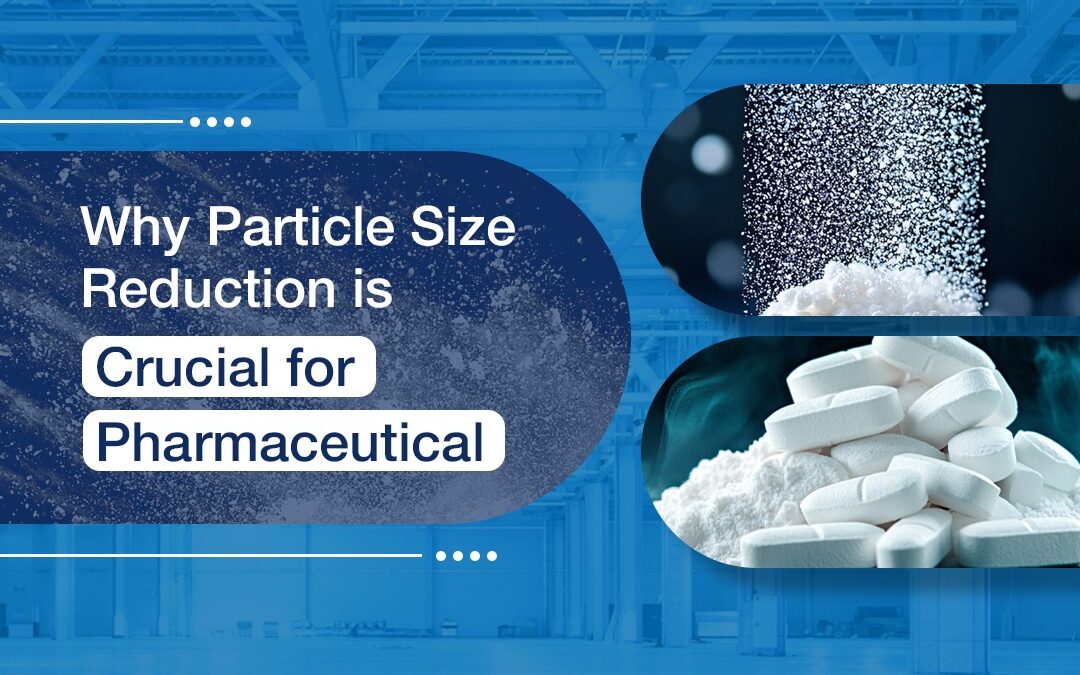Precision is non-negotiable across industries. Especially in pharmaceutical and chemical manufacturing.
Controlled processing ensures:
- Product quality
- Consistency
- Safety
As formulations grow complex, particle size reduction becomes critical.
It improves a lot of factors such as:
- Solubility
- Stability
- Bioavailability
It also enhances reaction kinetics and downstream processing. Controlled particle size distribution (PSD) ensures uniformity. It also ensure that the products meet strict regulatory requirements.
In industries like pharma and chemicals, the right particle size directly determines performance and compliance.
What is Particle Size Reduction?
Particle size reduction breaks larger solid particles. It turns them into finer and more uniform sizes.
This increases surface area and improves dispersion. It enhances the behaviour of materials during formulation and processing.
Common methods include milling and grinding. These methods use impact and attrition. Micronization is another method. It achieves submicron sizes using high-velocity air or fluid jets.
Wet milling combines shear forces and fluid dynamics. It is ideal for suspensions and dispersions.
Maintaining a tight and repeatable particle size distribution is essential. Even small inconsistencies can affect product safety and efficacy.
Importance of Particle Size Reduction in the Pharmaceutical Industry
In pharma, particle size impacts drug performance and regulatory approval.
Smaller particles dissolve faster, improving drug absorption and bioavailability.
Uniform particles ensure consistent ingredient distribution in tablets and capsules, supporting accurate dosing.
Well-sized powders have better flowability. They move smoothly through hoppers and feeders, reducing process interruptions.
Particle size reduction also helps control drug release profiles. It allows immediate-release or sustained-release formulations.
Meeting specified particle size distribution is essential for FDA, GMP, and pharmacopoeia compliance.
Key Benefits of Controlled Particle Size
A controlled particle size distribution reduces the risk of segregation and uneven dosing.
It:
- improves processing efficiency with smoother powder flow
- reduces disruptions in:
- mixing
- blending
- tableting
- ensures scalability
Lab-scale quality can be replicated at full production volumes
- lowers costs by reducing:
- waste
- batch rejections
- rework
Technologies Used for Particle Size Reduction
Different technologies serve different material needs.
Cone mills gently reduce size. They do so without generating excess heat. This attribute makes them ideal for heat-sensitive ingredients.
Comil
® mills are known for:
- Hygiene
- Precision
- Repeatability
They are widely used in pharma and food industries.
Micronization and jet milling use high-speed air for ultra-fine particles. No mechanical contact means minimal contamination.
Wet milling and high shear granulation are ideal for dispersions and emulsions requiring uniform PSD.
Deagglomeration is often achieved simultaneously, breaking clumps into individual particles.
Choosing the Right Particle Size Reduction Equipment
Start with material properties. Know hardness, abrasiveness, heat sensitivity, and moisture levels.
Define target particle size and acceptable particle size distribution.
Match equipment throughput to production needs, whether batch or continuous.
Ensure the design meets sanitary requirements like GMP and FDA compliance.
Check scalability. The system should deliver consistent PSD from R&D to commercial production.
Quadro Powder Processing Solutions
Quadro Powder Processing leads in precision milling.
Their Comil
® series delivers tight Particle size distribution with minimal heat and dust. The design is hygienic, meeting cGMP and cleanroom standards.
Quadro systems are scalable. Lab-scale results are easily transferred to production volumes without compromising PSD.
They are trusted worldwide in pharmaceutical, Food,neutraceuticals,chemical and cosmetic manufacturing.
IDEX MPT: Global Innovation with Local Expertise
IDEX MPT combines brands like Quadro, Fitzpatrick, and Microfluidics to offer complete processing solutions.
IDEX MPT provides localized technical support tailored to Indian industry needs. Factory-trained experts assist with process design, troubleshooting, and scale-up. Integration support ensures smooth equipment validation and commissioning. After-sales service keeps uptime high and operations efficient.
Also Read: Diaphragm Metering Pump: Benefits, Features & How It Works
Conclusion
Particle size reduction is essential for consistent product quality, stability, and regulatory compliance.
Whether for complex drug delivery or specialty chemicals, precise particle size distribution enhances processing and performance.
Quadro milling technology ensures reliable PSD, efficient deagglomeration, and scalable results.
With
IDEX MPT India, manufacturers gain global innovation and local support for critical powder processing.
Explore Quadro’s Particle Size Reduction solutions today and achieve precision from lab to plant.
